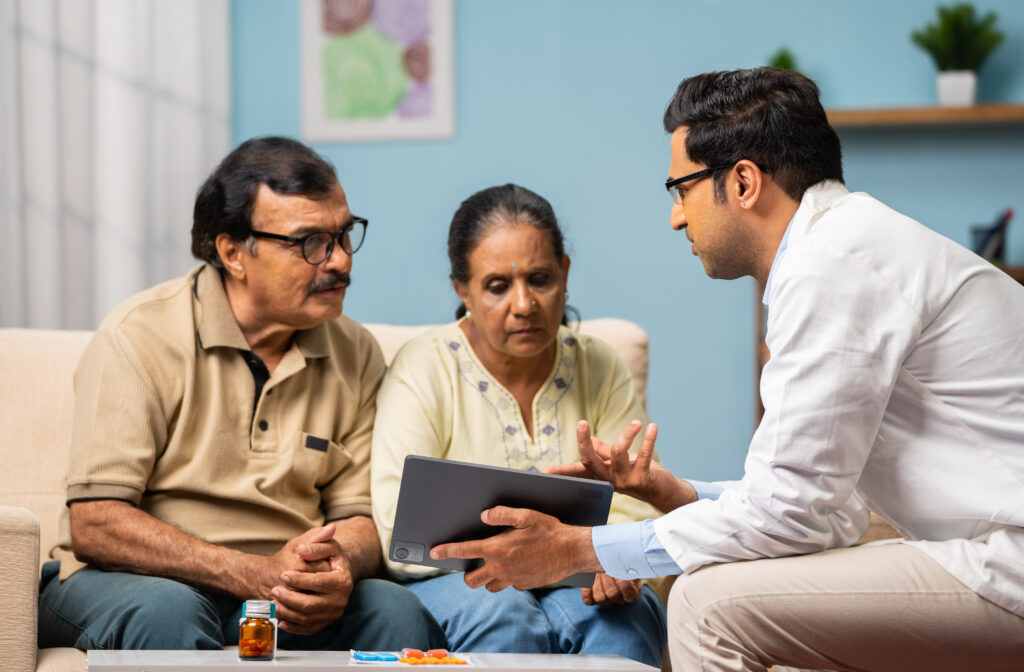By Alex Merckx, in conversation with Sarah Woozley
In today’s evolving healthcare landscape, and with adherence rates at just 50% for people with chronic conditions 1,2, Patient Support Programmes (PSPs) have become an essential tool in delivering personalised, patient-centred care. But according to Sarah Woozley, a seasoned expert in patient advocacy and engagement, it’s time to broaden our perspective.
“Patient Support Programmes have traditionally been about giving people information about their treatment,” Sarah explains. “But healthcare today is about more than just medication. It’s about holistic support that empowers people – including the HCPs – throughout their entire treatment journey.”

From Patients to People: Evolving the Language and Purpose of Patient Support Programmes
Patient Support Programmes are structured initiatives designed to help individuals manage their condition and adhere to treatment effectively. They often include educational resources, digital tools, and support mechanisms to help people set goals, monitor progress, and stay engaged with their care.
But Sarah believes the language we use matters: “I think they should be called person or people support programmes,” she says. “Yes, you’re supporting the patient, but ultimately, you’re also supporting the people around them – carers, families, and the healthcare professionals. It’s a whole ecosystem.”

A Shift Toward Personalised, Ongoing Support
Patient support programmes (PSPs) have long played a role in helping patients manage treatment. Traditionally, many programmes centred around patient-focused educational materials, occasional phone check-ins, or even home care teams providing in-person support—particularly for complex therapies.
Today, the needs and expectation of patients are changing, our HCPs are dealing with faster treatment progression and so the way support is delivered needs to evolve too. Programmes now must integrate digital engagement, offer real-time support -both sides of the consultation, offer scale and evolve as a patient’s treatment progresses. Sarah explains. “We need programmes that are ongoing, responsive, and tailored to where someone is in their journey.”
“When Patient Support Programmes are done right,” Sarah adds, “they don’t just educate—they give both patients and HCPs confidence, reassurance, and connection.”
Battling Misinformation in the Digital Age
Another growing challenge is the surge of online misinformation, particularly from unqualified influencers who present themselves as health experts.
“With the increasing number of online platforms, there is so much false information out there,” Sarah warns. “As a desperate patient or carer, you go looking for answers – and what you find might do more harm than good.”

With AI-generated content and deepfakes entering the mix, distinguishing credible sources becomes even more difficult. “It’s going to get harder to know what’s real. That’s why we need trusted, regulated voices in this space.”
Why Pharma’s Voice Matters—and Can Be Trusted
Despite lingering scepticism, Sarah believes the pharmaceutical industry is uniquely positioned to provide trusted information.
“We’re one of the most tightly regulated industries out there,” she says. “Everything we say to healthcare professionals has to be backed up by solid, clinical data. We can’t just make “claims” – there are stringent checks at every level.”
This level of regulation, she argues, should give patients and clinicians confidence in pharma-delivered education.
Pharmaceutical companies spend an enormous amount of time and money ensuring the safety and efficacy of treatments before they even get to market, and that’s in their interest. They know the data, they know the best patient profile, and they know how to get the best out of a therapy. It is in no-one’s interest to launch a treatment after all the time and investment, that gives anything less than optimal outcomes and experience: both by patient AND by HCPs. That’s why “Patient” Support Programmes should be considered “People” support programmes: when HCPs feel confident to coach, prescribe and help their patients initially, the support that’s then available to the patients has a higher chance of making a real impact: it’s a joined-up effort.
Designing Patient Support Programmes That Actually Work
According to Sarah, the most successful Patient Support Programmes are those that easily integrate into the systems and platforms healthcare professionals already use.
“ It’s not about using the most impressive technology or gadgets,” she says. “It’s about providing a platform that works with the set-up the HCPs already have. If you try to introduce something completely unfamiliar, no matter how fabulous, it just won’t get adopted. But if it complements existing processes, like existing prescribing systems, it has a real chance of being integrated.”
She adds that simplicity and intuitiveness are key: “Make it easy, make it familiar. That’s how you make it work: for the patients and for the HCPs.”
From One-Size-Fits-All to Truly Individualised Support
Modern Patient Support Programmes must go beyond just information – they need to offer personalised, emotional, and practical support. “We’re always saying that healthcare isn’t ‘one-size-fits-all,’” Sarah notes. “Whether it’s managing side effects, explaining the “why” or just making someone feel understood, being able to individualise the support given makes all the difference.”
“It’s not just about ticking boxes,” Sarah says. “It’s about listening, adapting, and offering support at the right time.”
Patient Support Programmes vs. Disease Awareness Programmes: What’s the Difference?
While both initiatives aim to improve health outcomes, their goals differ:
- Disease Awareness Programmes aim to educate the public about symptoms, risk factors, and when to seek help.
- Patient Support Programmes begin after diagnosis, offering ongoing education, self-management tools, and personalised support for people starting or continuing treatment.
“Patient Support Programmes are the bridge between diagnosis and optimal day-to-day management,” says Sarah. “That early stage is overwhelming. A well-designed Patient Support Programme gives people the confidence to move forward.”
The Impact of Patient Support Programmes: What the Data Shows

Evidence shows that when designed well, PSPs deliver meaningful results. A European review of Patient Support Programmes found that 75% of programmes meet their objectives, particularly those targeting clinical and economic outcomes, as well as patient satisfaction. 3
Meanwhile, studies show that structured PSPs can increase medication adherence rates by up to 66% (1), significantly impacting treatment effectiveness. Furthermore, research indicates that of patients enrolled in PSPs, 64% of patients experience improved quality of life, and 18.7% of programmes show economic benefits, such as reduced healthcare costs 4
Why Life Sciences Should Invest in Patient Support Programmes
For life sciences companies, the value of Patient Support Programmes extends beyond patient outcomes:
- Stronger engagement builds trust and brand loyalty.
- Real-world insights can drive better drug development and innovation.
- Improved adherence reduces costly complications and readmissions.
“When people feel supported, they understand the “why” and they’re more likely to stick with their treatment,” Sarah observes. “That benefits everyone—from the patient to the health system to the company.”
Case Study: Haemophilia and Injectable Treatments
This shift from generic information to intuitive, real-life tools is already happening—Sarah gives a practical example from her experience in haemophilia with patients, and their parents, starting injectable treatment, which can seem complicated and feel overwhelming for those new to the therapy.
To help, her team developed a simple, practical support kit, including a treatment tracker, a plain-language welcome guide, and an illustrated injection mat.
“The mat was especially effective,” Sarah explains. “It showed where each item—like the treatment vial, needle, alcohol wipes, sharps bin—should go, helping patients set up everything in the right order.”
This visual and tactile aid helped patients feel more confident managing their treatment independently. It also supported healthcare professionals during training, making the process clearer and less intimidating for everyone involved.
“It wasn’t high-tech, but it worked because it was intuitive and calming,” says Sarah. “That’s what patient support should be—simple, reassuring, and tailored to real-life needs.”
Practical Advice for Implementing Patient Support Programmes
Sarah offers these best practices for life sciences teams developing new support programmes:
1. Understand your audience – HCPs AND patients
“Start with the patient’s reality. What do they struggle with? What support do they actually want? For the HCP audience – what is their reality when they’re with these patients – their stumbling blocks?”
2. Co-create with stakeholders
“Bring patients, carers, and clinicians into the design process from day one to get genuine insights – not assumed insights.”
3. Work with experienced partners
“ Companies such as Cognitant live and breathe patient engagement—collaborate with them to make your programme truly effective.”
4. Don’t Forget the Basics: Communication, Literacy, and Accessibility
Sarah also emphasises the importance of accessibility – especially in the UK.
“We’ve got so many different languages and cultures. If your materials aren’t accessible, they’re not going to land.”
Conclusion: The Future of Patient Support is Personal
Patient support programmes have evolved dramatically. They’re now an integral part of the healthcare journey – supporting people in meaningful, measurable ways.

“The future of healthcare is individualised – for all involved,” Sarah emphasises. “And that’s exactly what Patient Support Programmes should be. Tailored. Trusted. Human.”
If we truly want to put people first in healthcare, we must move beyond passive, generic education and into proactive, personalised support. The time for transformation is now.

Sarah Woozley, Patient Engagement Expert
References
- Brown MT and Bussell JK. Medication adherence: WHO cares? Mayo Clin Proc 2011;86(4):304-14
- World Health Organization. Adherence to long-term therapies: evidence for action. Available at: https://apps.who.int/iris/handle/10665/42682 Accessed March 2021
- Shillington, A., Ganjuli, A. and Clewell, J. (2016). The impact of patient support programs on adherence, clinical, humanistic, and economic patient outcomes: a targeted systematic review. Patient Preference and Adherence, 10, p.711. doi:https://doi.org/10.2147/ppa.s101175.
- Sacristán, J.A., Artime, E., Díaz-Cerezo, S., Comellas, M., Pérez-Carbonell, L. and Lizán, L. (2022). The Impact of Patient Support Programs in Europe: A Systematic Literature Review. The Patient – Patient-Centered Outcomes Research, 15(6), pp.641–654. doi:https://doi.org/10.1007/s40271-022-00582-y.
Cognitant
Looking to empower people with health information for better patient outcomes?
Related News
Kidney Research UK invests in Healthinote patient education platform which could support >15m people with long term health conditions
April, 2025
Oxford, January 2025 – Kidney Research UK, the leading charity dedicated to kidney health, has made a significant investment in Cognitant Group Ltd, a leading...
Webinar Insights – Compliance vs Patient Engagement: Can They Co-Exist?
April, 2025
Is compliance really a barrier to meaningful patient engagement in pharma, or are outdated myths holding us back? In this recent webinar, Dr Tim Ringrose,...
Funding awarded to innovations that support early diagnosis and rehabilitation of Stroke patients
March, 2025
SBRI Healthcare, an Accelerated Access Collaborative (AAC) initiative, in partnership with the Health Innovation Network, has awarded £2.5 million for the development of five innovations...